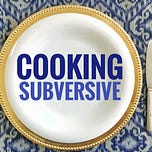#GeekingOutSeries/Safety101/KitchenDangerous/1
This post is part of the Geeking Out series which presents data-driven information on food and farming, safety in the kitchen, practical science for cooks, cooking techniques and processes and other relevant nerdy stuff that every cook should know. For the next few weeks, we will be covering topics from the chapter, Safety 101.
In January of 1999, I arrived in Boston to begin my new life as an adult student at the Berklee College of Music. New to the area, I arranged to stay with a friend’s friend who lived in the posh Back Bay area until I could find accommodations of my own. My new roommate was an avid cook. I, on the other hand, had very little cooking skills. So she generously cooked and shared her dinners with me.
One evening, my roommate went out to dinner and left me to fend for myself. I looked forward to my first Boston cooking experience. Back in Manila, I lived in households which employed a cook, so I wasn’t used to cooking, but had occasionally tried my hand at braising and pan frying. This wasn’t going to be a big deal except that I had always cooked with gas cook tops where the size of the flames clearly indicated how hot the burner was. This American kitchen had an electric range.
I don’t recall exactly what was on the menu other than it was going to be pan-fried, but I remember setting the range indicator to Hi, placing a skillet on the stove top and pouring olive oil into it. Within minutes, the olive oil in my pan was on fire. Flames licked out of my skillet, several inches high. Panic shot through my veins but not quick enough to stifle the little voice that told me to put the flaming skillet into the kitchen sink and grab its lid to cover and snuff it out.
Smoke set off the fire alarm, rudely piercing an otherwise quiet Saturday evening. I’d never handled a fire alarm before and didn’t know how to turn it off. Was my alarm triggering alarms in the rest of the building? It was so loud, I couldn’t be sure. I imagined the fire crew would arrive any minute and I’d have to explain the whole sorry episode while evacuated neighbors looked on. Maybe I’d get kicked out of the country for wasting tax payers’ money. Having averted a disaster, my chief concern now was preserving dignity. I ran out of the apartment into the hall and banged on the nearest door.
“Could you help me please? My smoke alarm went off and I don’t know how to stop it.”
The neighbor came over, opened the windows to let the smoke out then disconnected the alarm. Opening the windows hadn’t even occurred to me in my mental haze. So if my neighbor thought I was a silly foreigner, I didn’t mind. I was just grateful and relieved. It was my first week in Boston.
And this is how I learned that olive oil can catch fire.
Another important detail in this story is that I smothered the fire with a lid. Had I poured water, which may be instinctive to some, the story might have ended differently, if not tragically. I knew somehow that water on a greased-based fire would make matters worse and that I needed to cut off the oxygen which fanned the flames. In a panicked state of mind, I was grateful I could recall this bit of knowledge.
And then there was the matter of my unfamiliarity with electric stoves. With gas burners, you can easily see how hot your fire is. With an electric stove I’d never used before, I didn’t know how hot Hi could get. Now I do.
So what were my takeaways from this experience?
1. Know which cooking oils are for high and low heat and use accordingly.
2. Kill a grease-based fire by smothering it.
3. If unfamiliar with an appliance, use cautiously.
4. Know your neighbor.
You can bet I’ve learned these lessons well.
Today, the kitchen is a refuge for me, a place where I can be creative and have fun. But to the uninitiated or uninformed, just as I was back then, the kitchen can be a dangerous place. By sheer luck and some knowledge I’ve managed to avoid full blown disasters, and needless to say, these lessons are now indelibly etched in my mind. Making mistakes is a natural and inevitable part of the learning process, especially if you’re just negotiating your way around a kitchen. But I hope I can help you avoid some of the bigger ones.
Liar, Liar Pans on Fire: Fire and all things Hot
Many things in the kitchen can catch fire: Cooking oils; toast too near the heating element in a toaster oven; faulty appliances and overburdened or problematic electric outlets; ovens from grease build up; paper towels or other flammable objects near open flame; unattended pots with insufficient amounts of liquids. Before we cover all that, here is our first rule.
Rule Number 1: Keep on hand an extinguisher rated for grease and electrical fires AND a box of baking soda
No matter how careful you are, accidents happen and it’s best to be prepared. Kitchen fires are not uncommon. You have only to read customer reviews for kitchen fire extinguishers (I had recently replaced an expired one) to be convinced that this is an essential item. As to baking soda, I’ve not had to use it on fires myself, but pouring a box to extinguish fires is one of the recommended measures given by fire experts.
Though we plan for the worst, it’s best to note how we can avoid a fire in the first place. So we come to our second rule.
Rule Number 2: Avoid a Fire! Keep in mind the following guidelines for fire prevention
1. Grease is flammable. Good housekeeping means regularly cleaning ovens, stove tops, hoods and surfaces that may accumulate grease.
2. Keep flammable items, think paper towels, oven mitts, napkins, clothing items like scarves and neckties—away from burners and open fires.
3. Use only high-heat cooking oils for high-heat stove top cooking processes.
We use different kinds of fat for cooking. Olive oil, butter, lard (think bacon fat), duck fat, are some of the examples. Each one has a smoke or burn point, i.e. the temperature at which it starts to smoke and fats begin to break down, releasing chemicals that cause a bitter or burnt flavor. This also causes harmful free radicals to be released both into the air and food. At this stage, it’s not yet a fire hazard, but your food may be destined for the bin and you’ve just inhaled some naughty free radicals. But left unchecked, cooking fats can rapidly reach an ignitable temperature, the flash point, followed by the fire point, where it combusts. From my recollection, my pan caught fire in a matter of minutes.
Many factors affect cooking fat smoke points: its component, how they’re made— virgin or refined, cold or heat-processed, harvest conditions, even your pan’s surface area. While smoke point charts abound on the internet, it’s important to understand that these are data gathered in labs and based on the specific samples used. They make good guides but are not absolute. The cooking oil you use at home may have a different smoke point from what’s listed on the charts, so if available, it’s best to be guided by the manufacturer’s recommendation. For instance, though avocado oil is listed in some charts as having a smoke point of 400°F or less, my brand has High Heat 500°F printed on its label, and this is what I use for high heat cooking such as when frying (pan fry, deep fry, stir fry) which reaches temperatures upwards of 350°F.
It’s good to have a general understanding of smoke points so that you can safely match the cooking fat with the cooking process. Butter, depending on which chart you use, has a smoke point of 300°F and 350°F according to UC Davis and Serious Eats, respectively. The latter has extra virgin olive oil listed at 325-375°F. Both cooking fats are not suitable for frying.
A note on cooking fats: there are many types of cooking fats which vary not only by smoke points, but by flavor and health benefits, to be discussed in a future post. As a personal choice, I use avocado oil for high heat; animal fats like lard and duck fat as well as organic cold-pressed virgin coconut and extra virgin olive oils for low to medium heat; and butter for low heat cooking.
4. Don’t leave pots/pans unattended for any type of cooking that is quick, involves a high flame, hot exposed electric coil or any high heat such as when frying, sautéing, grilling or broiling. If you really need to leave the kitchen (such as for an emergency bathroom run), turn off burner or oven.
5. Set a timer or reminder to check on food items that are slowly cooking such as when you simmer, steam or bake should you leave the kitchen. When simmering and steaming, you need to make sure there is always sufficient liquid. And when done, always turn burners/stove off.
6. Keep appliances well-maintained. If an appliance starts to smoke or you see sparks, turn off immediately and unplug. You may also need to turn off the circuit breaker.
For additional information, check your local fire department’s guide on fire prevention.
This is the end of part 1 of Kitchen Dangerous
Interested to learn more? Read companion posts on Cooking Subversive:
The Kitchen Dangerous series
Part 1: Liar, Liar Pans on Fire: Fire and All Things Hot
Part 2: Don’t Burn Yourself
Part 3: More Hot Stuff
Part 4: Knives and Other Sharp Things
Part 5: First Aid for Cuts (and Burns)















Share this post